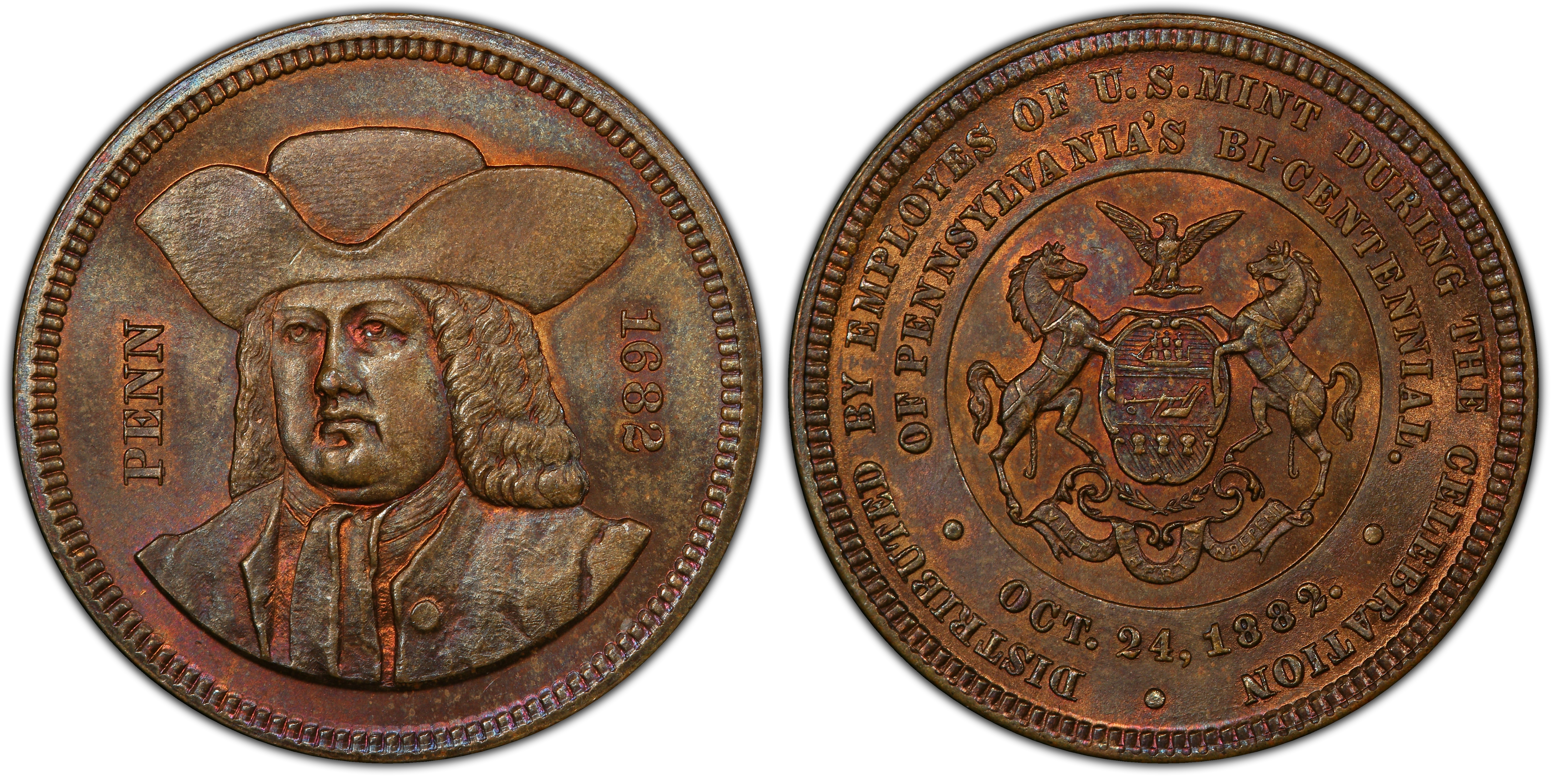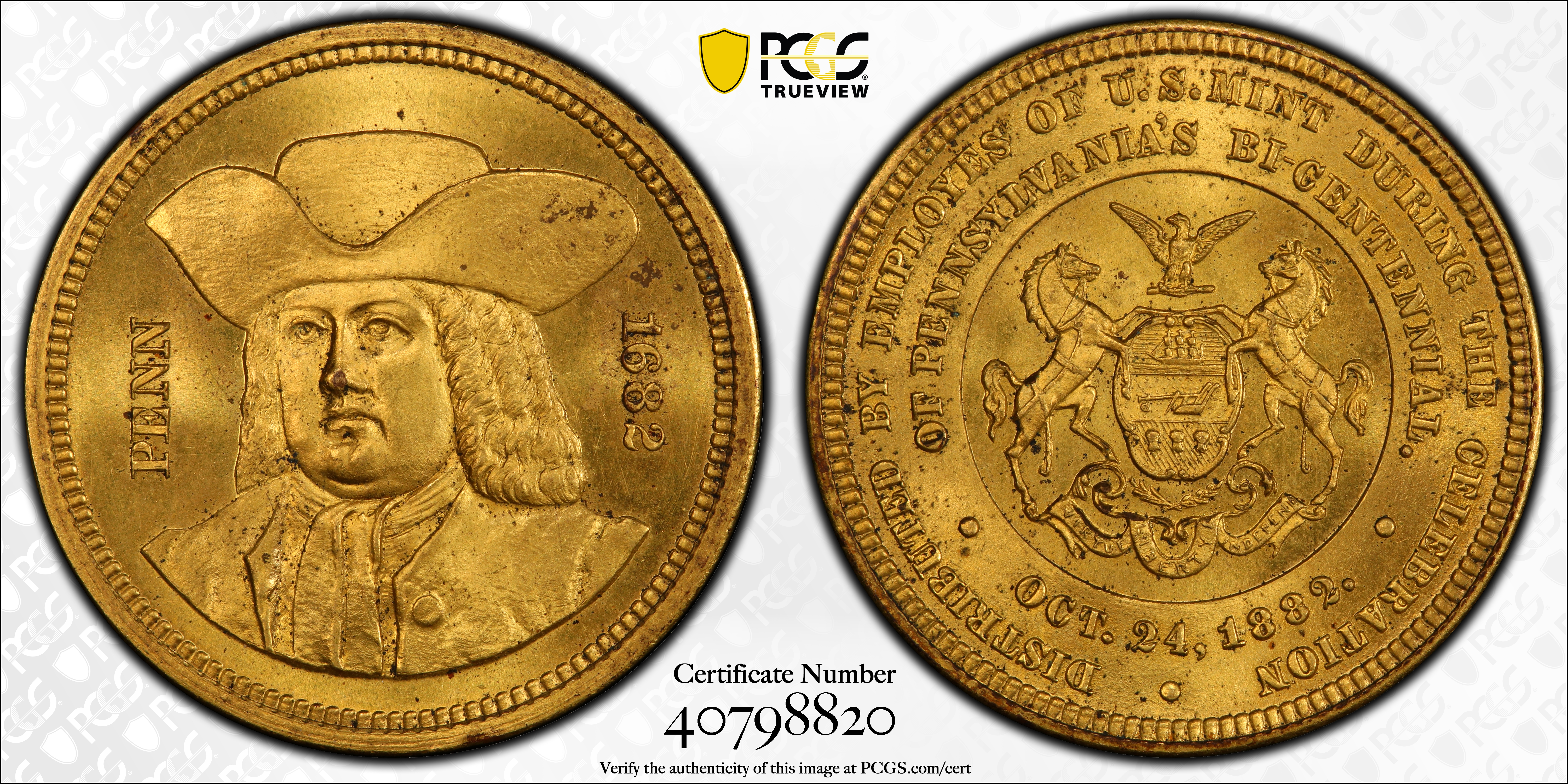Rare US Mint Medals - 1882 Pennsylvania Bi-Centennial
Here are a couple of my US Mint medals / So-Called Dollars from the 1882 Pennsylvania Bicentennial. I like the 1882 William Penn pieces because the William Penn bust is also used on the more common, smaller medals, both being done by George Thomas Morgan.
I'm very surprised by how rare these seem to be. Any ideas why?
The following are:
- HK-138 NGC MS64 POP 1/2/0
- HK-139 Restrike NGC MS66 POP 0/1/0

1882 200th Anniversary of the Landing of Penn - HK-138
So far I've only seen 3 specimen of this:
- Jeff Shevlin Specimen
- John Dean Specimen
- Zoins Specimen
NGC has 3 in the census, two at MS64 and 1 at MS61. PCGS has certified 0.
Aside from mine, none have been sold by Heritage, Stack's and eBay (using Worthpoint), which I find very interesting.
1882 Pennsylvania Bi-Centennial Mint Officers - HK-139
This one seems a bit more common with a number appearing in past auction records, but still rare.
- Heritage: 4
- Stack's: 1
- eBay: 3
- NGC: 6 (2 in PL)
- PCGS: 0
1882 Pennsylvania Bi-Centennial Mint Officers - HK-139 Restrike
This is a rarity as only 1 exists in NGC and I haven't run across another anywhere.
I wonder if this was a one-off piece that was made when other other restrike medals were being made.

Here are photos of the other 2 HK-138 specimens.
John Dean Specimen
As seen on the HK website:
https://www.so-calleddollars.com/Events/Pennsylvania_Bicentennial.html

Jeff Shevlin Specimen
As seen on his website:
http://www.so-calleddollar.com/scd/william-penn-pennsylvania-bicentennial-official-medal/

Comments
As far as rarity goes, I have no real idea but only a guess.
Penn. is an old state with old money and maybe some are sitting in heirloom collections.
Just a guess.... probably not a good one either.
Is there no indication of actual quantity minted? That could be an indicator of rarity as well....Cheers, RickO
I haven't seen any mintage records for this and would love to see some. I wonder if Roger could dig up any records on this.
These use the same obverse design as the following which is often encountered in brass. The brass version was planned to been thrown into a parade from a wagon drawn by 6 horses with a steam press. I've never seen a photo of the parade float but it would have been interesting. Anyone have one?
Here's the mintage of this one. I only have the common version and the following gilt version below.
1882 Pennsylvania Bi-Centennial Mint Employees Medal - Gilt - NGC MS66 POP 16/2/0
I was lucky enough to pick up the following. I'm still looking or a silver and gold
HK-139 appears for sale roughly in similar numbers as the silver version of the smaller CM-42. HK-138 appears roughly half as often.
The silver version of CM-42 had an original mintage of 100.
If we assume round numbers for HK-139 and HK-138, the original mintages were likely 100 and 50, or maybe 200 and 100.
Good thinking. I didn't think about comparing the silver CM-42 with HK-139 but you're right in that both do appear every so often.
Jesinger Specimen of HK-138
Don Ensley Specimen of HK-139
Pioneer Specimen HK-139 (Details... either the gilt wore off.. or it was struck in bronze and damaged)
A So-Called Dollar and Slug Collector... Previously "Pioneer" on this site...
Wow! Great to see all of those. I've been looking for these all over. Thanks for posting them!
The Pioneer HK-139 is interesting. Has all the gilt ever been known to wear off a piece like that or is it much more likely that it was never gilt to begin with?
Yes that is why I included the photo. I have seen all sorts of situations, but there are definitely patterns to what you find. There definitely are bronze/copper pieces that come gilted and without gilt (even though HK might only say there is the gilt variety). J.Shevlin's new pocket price guide to West Coast Expos shows alot of this. Some pieces have minimal gilting and hence are "defective" in that the plating didn't fully take during manufacturing (opening day HK-245 comes to mind). I've seen totally ungilted original pieces and others where the gilt has worn off ... and others where the gilt is gone from abuse (corroded from being in the ground, near the ocean salt water, etc). Finally, there are planchet defects on some SCDs where the piece has planchet metal layers that are separating and oxygen is killing the piece. Anyone who collects SCD long enough will know what HKs i'm talking about (like HK-758 from New Orleans and HK-638 Western Reserve). Of course, a lot of GILT-LESS pieces (presumed damaged) can be found in the 1908 USN Voyage series (HK-350 to 352d).
As for the HK-139... I haven't seen enough of them in person to tell you what I think the pattern is...
A So-Called Dollar and Slug Collector... Previously "Pioneer" on this site...
Here is an example of a medal that has a funny coating on it.... I've seen this on HK-638 and HK-758 versions as well... I think was this plated with some kind of chocolate coating to preserve the underlying medal ... or a way to simulate bronze when it's not ? Any thoughts / comments on this ? Has anyone seen this on other medals ?
A So-Called Dollar and Slug Collector... Previously "Pioneer" on this site...
It's an oxidation layer on the white metal composition. Different types of white metal oxidize in different ways. Also depends on the environment the metal was stored in.
Oxidation is a surface effect. When the oxidation is heavy and the composition is fragile, the oxidized layer can flake off.
It would be an interesting study to get elemental analyzes for various types of oxidation. Needs someone with direct access to an elemental analysis machine and doesn't need to pay for each analysis...
Do you think this occurred naturally or by manufacture? It seems like this "effect" isn't common in all the SCD WM pieces i've seen... which makes me think there was some intentional effort to get certain HKs to look like this.
A So-Called Dollar and Slug Collector... Previously "Pioneer" on this site...
@Pioneer1 I think that it occurred naturally, mainly as a result of the composition. "White metal" does not have a standard recipe. Different types of white metal oxidize in different ways.
Some medals are notorious for oxidizing poorly. (example) (example)
This HK-139 is one of just 6 graded by NGC and closed on the bay tonight at $424.00.
I still need HK-139 so let me know if there's one available
If we're doing a census, here's a couple more
Great to see these @jonathanb! Given how rare these are, a census is really interesting to track all specimens!
I'm still surprised by how rare these are.
Nice
Thanks Jonathan for sharing your pieces !
A So-Called Dollar and Slug Collector... Previously "Pioneer" on this site...
A So-Called Dollar and Slug Collector... Previously "Pioneer" on this site...
Beautiful specimen @Pioneer1 !
Great to see TrueViews of these!
How would you describe it in hand?
It's fairly similar to the photo... nice in hand
A So-Called Dollar and Slug Collector... Previously "Pioneer" on this site...
Separated at birth 🤔

Mr_Spud
Just ran across this again and wanted to say this looks great!
And thanks to everyone for posting your specimens!
It's not in the NGC cert lookup... I e-mailed NGC to see why and if that can be corrected
A So-Called Dollar and Slug Collector... Previously "Pioneer" on this site...
Looks like it's corrected now

That's a great looking specimen. I wonder if this is an Ostheimer-Perkins piece?
https://www.ngccoin.com/certlookup/2023972-012/63/
@Pioneer1 Do you know if the HK-139 you posted was owned by @WDP?
I wonder if it can be called the Ostheimer-Perkins specimen?
The pops for these haven't changed much since this thread was posted.
HK-138 is now POP 2/2/0.
HK-139 Restrike is still POP 0/1/0
I was lucky enough to see this at the So-Called Fellowship Gathering this year. Thanks @Pioneer1! It's a really interesting piece.
It's great to see pieces where the gilt has worn off. I have this HK-306 in NGC MS63 which is unusual for having the gilt worn off and still grading unc. I spoke to Jeff and he indicated that the gilt can "chemically evaporate" if the coating is very thin.
Are these the same specimen? They seem to have some of the same diagnostics but some that I can't match and they have very different looks in the photos.
Yes, definitely the same.
I have the bronze and the gilt. Both PCGS true views
.


.
CoinsAreFun Toned Silver Eagle Proof Album
.
Gallery Mint Museum, Ron Landis& Joe Rust, The beginnings of the Golden Dollar
.
More CoinsAreFun Pictorials NGC FOR SALE
Thanks. Looks the same to me too
Those are great pieces Stef!
There's some good discussion of these in this thread by @jonathanb:
https://forums.collectors.com/discussion/735898/1882-wm-penn-pennsylvania-bicentennial-medal
I have a number of these Julian CM-42 medals as well. Here's mine in gilt:
Here's a PhotoVision of the still unique HK-139 Restrike. I've discussed this with a few people and it's amazing that this is still the only one known.
Given that the smaller medals are commonly listed with their Julian CM-42 numbers, are HK-138 and HK-139 listed in Julian?
Yes, HK-138 is Julian CM-40 and HK-139 is Julian CM-41
Good to know.
It would be a great presentation to have CM-40, CM-41, and CM-42 in a multi-holder.
Does anyone have any theories on the origins of the HK-139 restrike?
Here's a modern restrike for Julian LS-4, also with only 1 in the pops. Are any other modern restrikes of this known?
Cert: https://www.ngccoin.com/certlookup/6463594-005/65/
That HK-139 restrike is hard to date. It is likely post-early-1930’s based on the surface appearance, and maybe no later than the end of that decade.
There are many, many modern restrikes of that LS-4. This is such an undesirable medal, that restrikes tend to sell for less than $15.
Great info @GoldenEgg and thanks for agreeing @jonathanb!
Modern restrikes are an area I'm just starting to look into.
Are there specific medals from the 1930s that have this look?
Good to know. This seems to be an odd medal to make so many restrikes. Were these sold or what reason was there for striking so many of these?
Ok, so I noticed this on the other thread with one specific example of the gilt bronze smaller medal, however Penns pupils in that one specific one were looking directly at us, whereas in all the rest, they look off to the left, even in mine they do this. So I came back here to see the larger shown "dollar" examples from 1882 amd lo and behold, one in particular, I can see the pupils looking directly at us, leading me to believe that two specific varieties of the obverse exist and one is MUCH RARER than the rest as so far in both threads I have seen only one example of both types looking right at us. Here, it is the Jeff Shelvin specimen of the larger "dollar" version. Correct me if I'm wrong, but... did I just discover a die variety inadvertently using photos of specimens other people are holding through the powers of my autistic observation? I have seen literally zero discussion on this point until I observed it today.